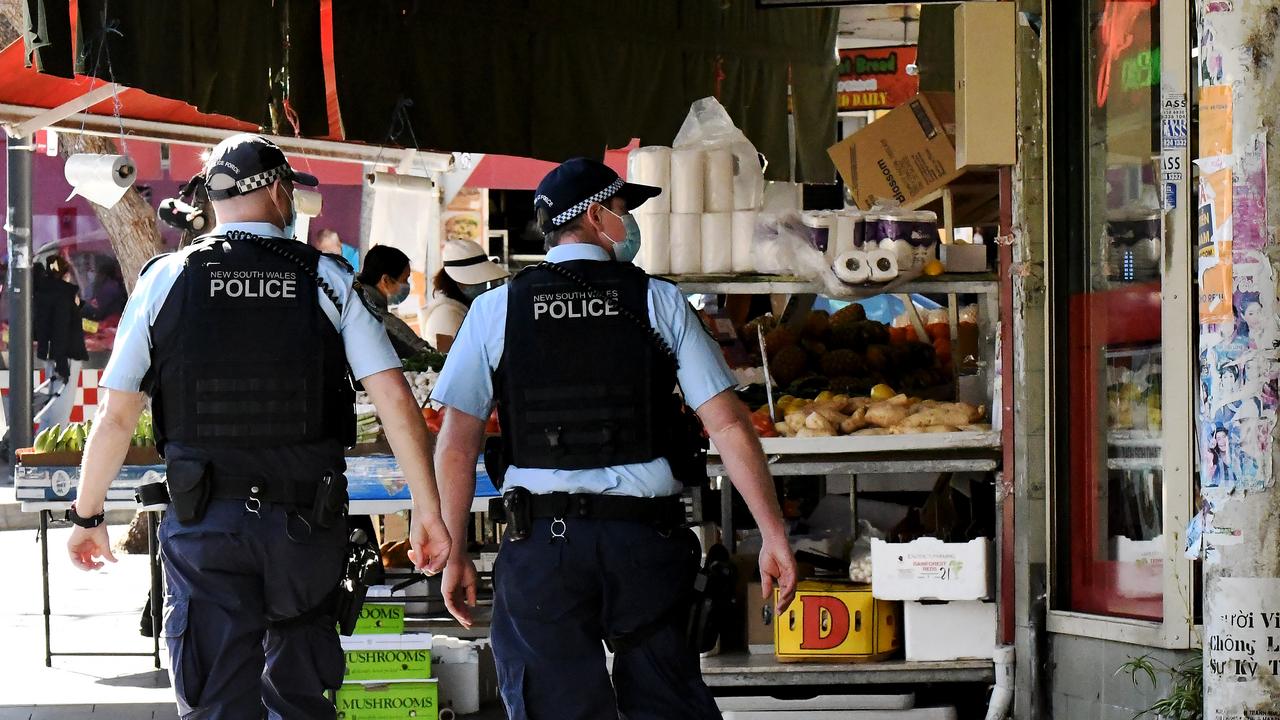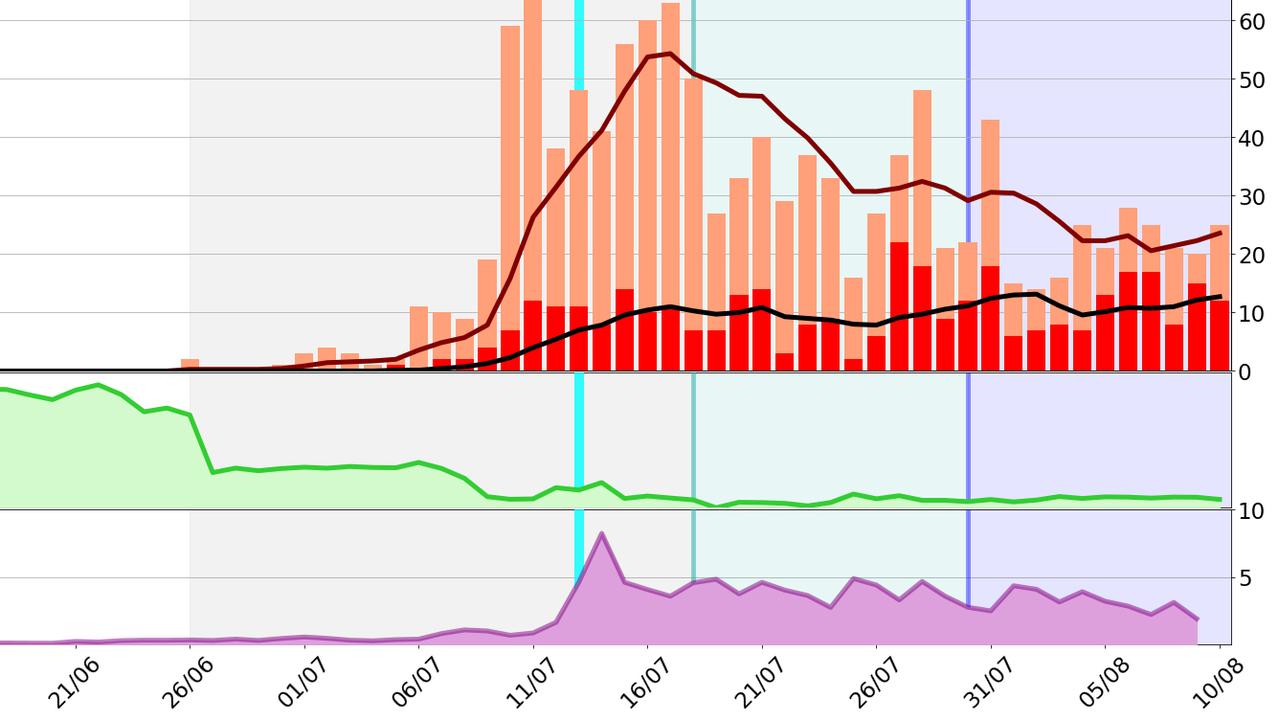The Sydney suburbs where NSW’s Covid strategy is working
Restrictions in some Sydney suburbs look to be working, providing hope that NSW can drive cases down despite the infectiousness of Delta.
New South Wales’ Covid strategy could be working with data showing the epidemic curve is bending in certain local government areas.
On Wednesday, NSW Premier Gladys Berejiklian acknowledged the state’s success in Fairfield and Canterbury-Bankstown areas, which were among the first of eight LGAs identified as being of concern.
Residents in the two LGAs have been subjected to tougher restrictions including Covid testing every three days for any essential workers required to leave the area, a 5km travel limit, as well as compulsory vaccinations for construction workers.
Authorities have poured resources into the areas, ramping up Covid testing sites and priority vaccinations for those in Year 12. Police have also increased compliance checks in a controversial move that has left some residents feeling “targeted”.
The increased focus appears to have paid off though, with Ms Berejiklian telling reporters on Wednesday there had been a decline in the number of cases in the two LGAs.
“We are starting to see a decline, so that intensive work we have been doing is starting to have effect, and we are asking the community to keep going, stick to the rules,” she said.
Deakin University epidemiologist Professor Catherine Bennett told news.com.au she did think there was some good news in the numbers.
“Ideally we would do this everywhere but they don’t have the resources,” she said.
However, she said the tactic of focusing resources in specific areas did seem to be working better than diluting them and trying to spread them out citywide.

“The question is always how quickly do they have to move to get ahead of it,” she said.
Prof Bennett said authorities were widening the areas of concern once they began to see cases rise but believes they should be acting more quickly, and should consider ramping up testing and community engagement in neighbouring areas as well.
“Going in sooner might create a better buffer zone and if they are likely to go into tighter lockdown anyway, it’s better to do it earlier,” she said.
“By the time they see cases, the virus has already taken off.”
Prof Bennett said measures that could be introduced in neighbouring areas could include more mobile testing, including for health and age care workers, and initiating community partnerships with local leaders to communicate the risk of house to house transmission.
“It’s doing what they do, but going in a bit earlier to prevent transmission rather than to suppress it once it’s already started to happen,” she said. “Getting ahead of the game.”


Dataset just updated!
— Dan Babs (@DanDbab) August 11, 2021
Some points from today's NSW presser:
* Canterbury-Bankstown decline
* Burwood, Bayside, Inner West, Strathfield, other LOC-adjacent LGAs "On watch ... important everyone in those areas know cases are rising"
* Hunter outbreak growing
See below . . 1/n pic.twitter.com/RdIsyS1ofS
Melbourne University epidemiologist Professor Tony Blakely said the downturn of cases in individual LGAs is what you would expect with the “whack a mole” strategy NSW is pursuing.
“In those LGAs with very tight restrictions, numbers should turn and go down,” he said.
“But the virus will leak out elsewhere, and rates will start to go up in LGAs with lesser restrictions – which then go into harder restrictions, and the virus goes off somewhere else to cause problems.”
Prof Blakely said this type of strategy was a bad idea if the goal was to eliminate the virus, however, this may now be beyond NSW and Sydney in the medium term.
“If the strategy now – as I suspect it is, and may be the best strategy – is to ‘bridge over’ to October or November when the vaccine coverage is higher, then tightening restrictions where rates a high is appropriate,” he said.
He said this would keep numbers somewhat under control across the city without having the entire area in hard lockdown.
“It is an extraordinarily difficult time as a chief health officer and Premier to be making these decisions,” he said.
“It truly is about trying to pick the least worst option, balancing up the health and societal and economic impacts.”
Re: LOC-adjacent LGAs, can clearly see the concern with Bayside. Strathfield and Inner West also flagged as a concern.
— Dan Babs (@DanDbab) August 11, 2021
Meanwhile the list of LGAs outside Greater Sydney keeps growing. Hunter outbreak showing steady growth at the moment This needs its own vis I think. 3/n pic.twitter.com/swfbfYDtdX
Cases are already increasing in some neighbouring areas, helping to fuel the total number of cases in NSW, which continues to rise.
NSW chief health officer Kerry Chant said numbers were growing in LGAs including Inner West and Strathfield, which border Canterbury-Bankstown.
She said numbers in Cumberland, which is next to Fairfield, were still very high, as were numbers in Bayside and Georges River.
“It is important that everyone knows that there is an increase in cases in those areas, and for them to come out and get tested and assist us with control,” Dr Chant said.
Liverpool, which went into a stricter lockdown at the same time Fairfield and Canterbury-Bankstown, also hasn’t shown the same decline.
The virus also seems to be spreading into regional areas, with several also now in lockdown, including Armidale, Byron Bay and Dubbo.
Authorities indicated that Greater Sydney residents may be living with restrictions for a lot longer, with Ms Berejiklian saying it would likely take until the end of October for 70 per cent of the state’s residents to be vaccinated, a figure that may make it safe to ease lockdowns.
Prof Bennett said the success in driving down cases in certain areas does not meant the citywide lockdown could ease, as people who were not showing symptoms could still spread the disease without knowing it.
“Everyone is still at risk so a general lockdown is important,” she said.
charis.chang@news.com.au | @charischang2




